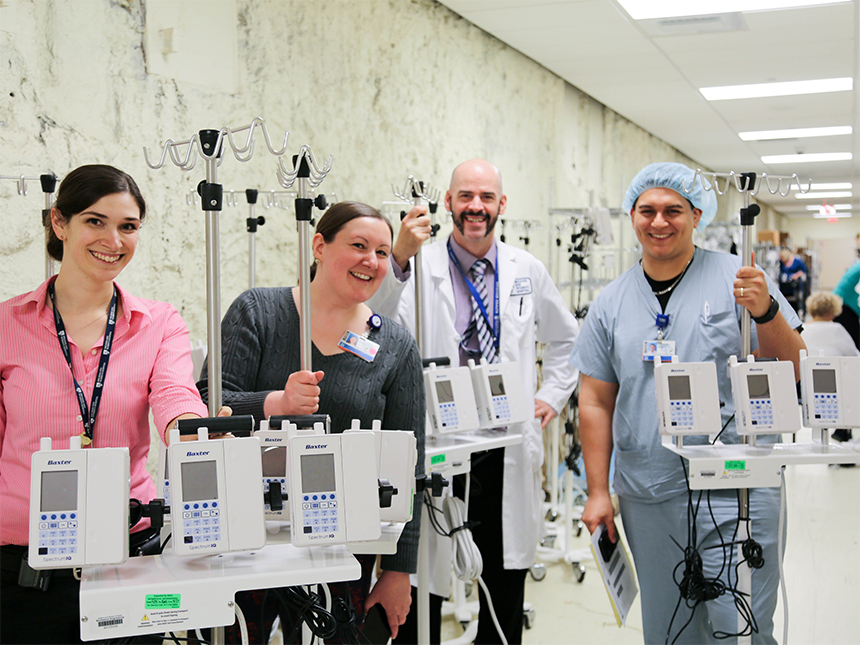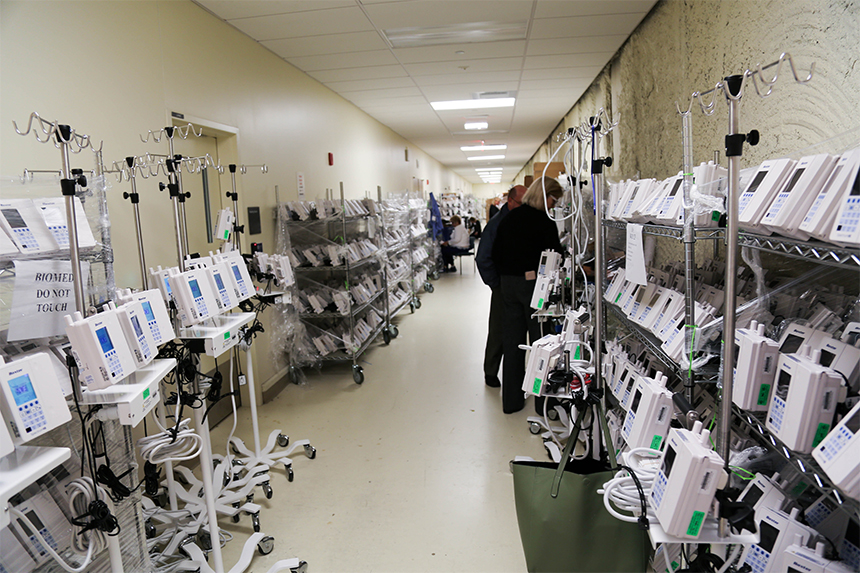Get Pumped: Brigham Completes Infusion Pump Transition

From left: Hannah Frank, Elizabeth Brosseau, William Smith and Andrew Green
On May 19, an unusual scene unfolded in hallways across the hospital as staff wheeled thousands of new infusion pumps, IV poles and related equipment into patient care areas.
The 12 teams, comprising Brigham staff and Baxter representatives, replaced approximately 3,800 large-volume infusion pumps on the main campus with a new model, the Baxter Spectrum IQ pump. The transition was part of a system-wide goal of wireless, auto-pump programming and auto-documentation in Partners eCare, which will help to enhance the safety of IV pump programming. Brigham Health is the first in the Partners HealthCare system to “go live” with the Baxter IQ pump, and other Partners institutions will follow in a phased approach.
 “This was a major undertaking that required leadership and collaboration from staff in many departments over the last few months,” said Maddy Pearson, DNP, RN, NEA-BC, chief nursing officer and senior vice president of Clinical Services. “We are deeply grateful for their extensive efforts to help us prepare for this rollout and ensure that all staff had the training and support they need to safely care for patients during and after the transition.”
“This was a major undertaking that required leadership and collaboration from staff in many departments over the last few months,” said Maddy Pearson, DNP, RN, NEA-BC, chief nursing officer and senior vice president of Clinical Services. “We are deeply grateful for their extensive efforts to help us prepare for this rollout and ensure that all staff had the training and support they need to safely care for patients during and after the transition.”
Michael Fraai, executive director of Biomedical Engineering and Device Integration, thanked everyone involved for their hard work and contributions, as they ensured the transition was safe, efficient and seamless — an especially impressive accomplishment given the deployment’s scale and complexity.
“This was truly a collaborative effort among several departments. We all worked together to accomplish this goal,” Fraai said.
The Baxter pump was selected after hundreds of hours of demonstrations, with more than 1,500 evaluations from staff, including Brigham nurses. Each day, nurses, anesthesiologists and respiratory therapists use large-volume infusion pumps to deliver nutrients, blood and medications to patients in inpatient units, procedural settings, ambulatory clinics and the Emergency Department.
Ready to Launch
Beginning at 6 a.m. on May 19, multiple project teams from the Brigham and Baxter visited units and practice areas to replace pumps and tubing — all while working efficiently to minimize disruption for patients and their families. The team comprised approximately 120 Brigham Health faculty and staff from more than a dozen departments and 40 Baxter representatives.
Jon Silverman, BS, PharmD, supervisor in Pharmacy Services, was part of the team that implemented the former Alaris pumps in 2003. He looks forward to seeing how the new features in the upgraded devices will enhance care and make life easier for providers working in Partners eCare.
“This is an important step in providing the safest care for our patients. We are so excited to be on the cusp of completing this transition, leading ultimately to auto-pump programming and auto-documentation,” Silverman said.

New infusion pumps line a hallway in the Shapiro Cardiovascular Center in preparation for the upgrade.
After completing the main campus implementation, teams continued the deployment of Baxter pumps throughout the week at Brigham and Women’s Ambulatory Care Center at 850 Boylston St. and the Brigham and Women’s/Mass General Health Care Center in Foxborough. Brigham and Women’s Faulkner Hospital will transition on May 29.
Since the deployment, super-users and professional development managers on each unit have been available to provide “at-the-elbow” support to providers.
Seeing the transition come to fruition after so much careful planning was exciting for Anne Bane, MSN, RN, nurse director of Informatics and Medication Safety, who served as one of the clinical leads for the project.
“I was proud to have my colleagues work alongside me — they made this project seamless,” Bane said. “Everyone was so helpful and extremely vested in patient safety. It was impressive to see how we were able to move 7,000 pieces of equipment in one day and transition all patients to the new IV infusion pump.”

Leave a Reply